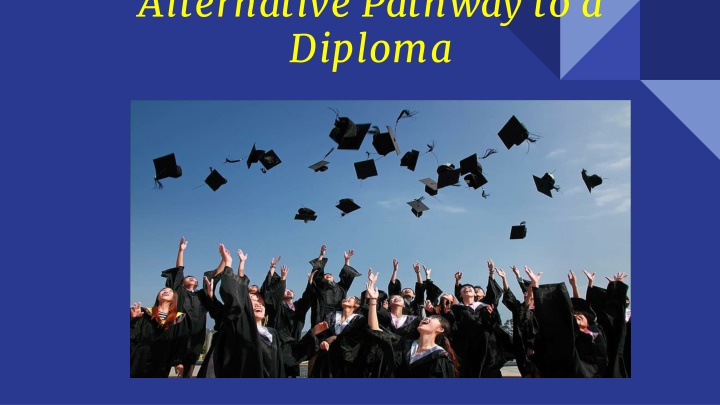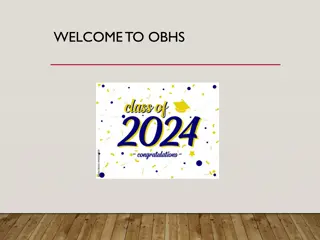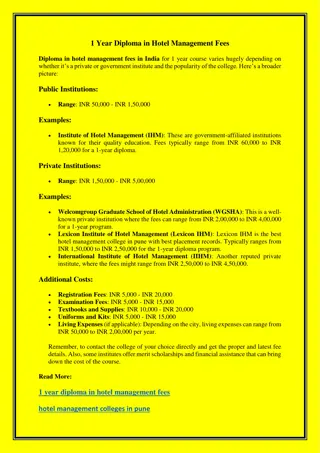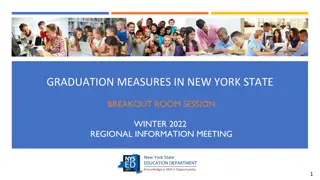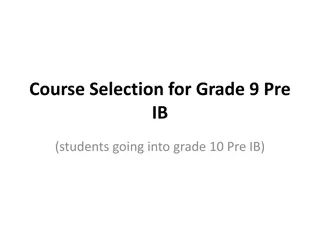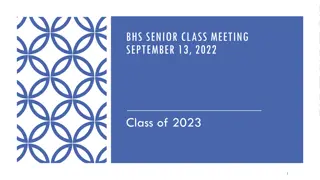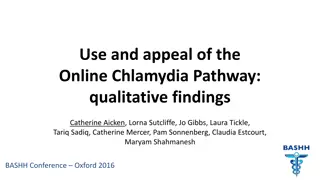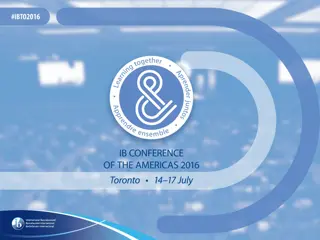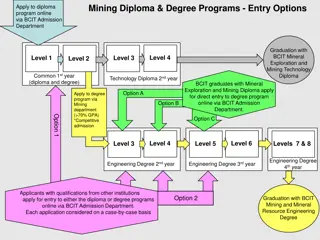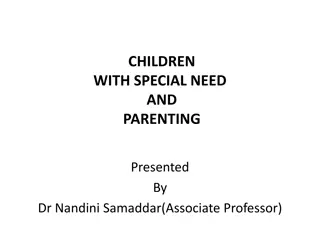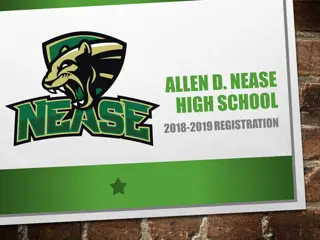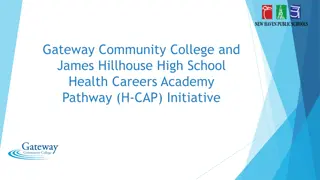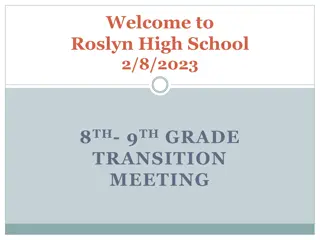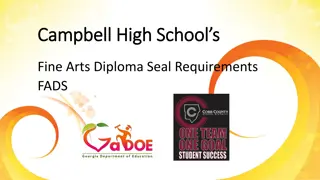Alternative Pathway to a High School Diploma for Students with Exceptional Needs
This information outlines an alternative pathway for individuals with exceptional needs to earn a high school diploma, exempting them from certain coursework requirements. The pathway is designed to support students historically considered mod-severe, now identified as needing ESN support. Students on this pathway must meet California State graduation requirements and enroll in specific courses. The provided details unpack the relevant education code, graduation requirements, and the internal tracking process.
Download Presentation

Please find below an Image/Link to download the presentation.
The content on the website is provided AS IS for your information and personal use only. It may not be sold, licensed, or shared on other websites without obtaining consent from the author.If you encounter any issues during the download, it is possible that the publisher has removed the file from their server.
You are allowed to download the files provided on this website for personal or commercial use, subject to the condition that they are used lawfully. All files are the property of their respective owners.
The content on the website is provided AS IS for your information and personal use only. It may not be sold, licensed, or shared on other websites without obtaining consent from the author.
E N D
Presentation Transcript
Alternative Pathway to a Diploma
Ed Code 51225.31 on January 1st, 2023 (a) (1) Notwithstanding any other law, a local educational agency shall exempt an individual with exceptional needs who satisfies the eligibility criteria described in subdivision (b) from all coursework and other requirements adopted by the governing board or governing body of the local educational agency that are additional to the statewide coursework requirements specified in Section 51225.3 and shall award the pupil a diploma of graduation from high school, as described in Section 7801(23)(A)(ii)(I)(bb) of Title 20 of the United States Code.
Unpacking Ed Code 51225.31 (a) (1) Notwithstanding any other law, a local educational agency shall exempt an individual with exceptional needs who satisfies the eligibility criteria described in subdivision (b) Every school district, charter school or Non-Public School (NPS) must adopt an Alternative Pathway that leads to a High School Diploma.. LEAs will establish an internal process to track the student s progress on this pathway. This pathway is intended for the most impacted students who have historically been considered mod-severe (now referred to as needing ESN support) and on a Certificate of Completion pathway.
Unpacking Ed Code 51225.31 from all coursework and other requirements adopted by the governing board or governing body of the local educational agency that are additional to the statewide coursework requirements specified in Section 51225.3 Students will need to meet CA State graduation requirements. Students on this pathway do not need to meet other LEA adopted requirements for a diploma, such as A-G requirements. Students will need to be enrolled in an alternative diploma pathway either via inclusion in general education or in an SDC Program with appropriate courses.
Graduation Requirements for Alternative Pathway https://www.cde.ca.gov/ci/gs/hs/hsgrmin.asp Unless otherwise specified, each course shall have a duration of one school year: Three courses in English Two courses in mathematics, including one year of Algebra I (EC Section 51224.5) Two courses in science, including biological and physical sciences Three courses in social studies, including United States history and geography; world history, culture, and geography; a one-semester course in American government and civics, and a one-semester course in economics One course in visual or performing arts, world language, or commencing with the 2012- 13 school year, career technical education. Two courses in physical education, unless the pupil has been exempted pursuant to the provisions of EC Section 51241
Sample Pathway for an SDC Program 9thGrade Fundamental English 9 10thGrade Fundamental English 10 11thGrade Fundamental English 11 Fundamental Math 11 or Consumer Math Alt Science in Everyday Life or elective 12thGrade Fundamental English 12 or elective EC 51225.3 3 - English Courses 2 Math incl. Algebra unless waived Fundamental Math 12 or Math for Life Math 1 or Algebra Math 2 2 Science Courses: incl. biology and physical science Fundamental Biology Fundamental Physical Science Career Awareness & Exploration Geography/World History and Current Events HS US Government & Economics or Elective Life Skills or elective 3 - Social Studies Courses Alt US History 1 - Elective from VPA, World Language and/or CTE General Education Elective Independent Living Skills I Independent Living Skills II Vocational Skills or Job Shadow Communication & Social Skills or elective Communication & Social Skills or elective Physical Education or APE Physical Education or APE EC Section 51241: (2) Courses in PE
Alternative Pathway - Who is eligible? To qualify for this pathway, students must be eligible to take the CAA, as indicated in their IEP. If these students are also English Language Learners, the IEP team should consider the Alternative ELPAC along with the CAA at the IEP meeting.
Resources - California Alternative Assessments CAA Assessment Fact Sheet https://www.cde.ca.gov/ta/tg/ca/documents/caaelafactsheet.pdf CDE CAA information https://www.cde.ca.gov/ta/tg/ca/altassessment.asp Alternative Assessment IEP Team Guidance https://www.cde.ca.gov/ta/tg/ca/caaiepteamrev.asp Alternate Assessment Participation Decision-Making Tool for California https://www.cde.ca.gov/ta/tg/ca/documents/altassessmentdecision.pdf
Content Standards Common Core State Standard Core Content Connector Essential Understanding For students taking the CAA, the content of the alternative pathway to a diploma courses is derived from the common core state standards (CCSS). Students should access, by ability, either the CCSS, Common Core Connectors or Essential Understanding of the standard. Core Connectors & Essential Understanding Rubric for Reading, Writing, and Math https://www.cde.ca.gov/ta/tg/ca/altassessment.asp
Alternative Pathway (2) In accordance with Section 300.102(a)(3) of Title 34 of the Code of Federal Regulations, the award of a diploma of graduation from high school pursuant to this subdivision does not change a local educational agency s obligation to provide a free appropriate public education or otherwise constitute a change in placement. The LEA is still responsible for FAPE until the student is 22 years of age for students on the Alternative Diploma Pathway.
The Algebra/ Int. Math 1 Question Q. Do special education students have to meet this requirement? A. Special education students have to meet the Algebra I/Mathematics I graduation requirement. In order to earn a high school diploma, students in special education are required to pass a course or combination of courses based on all Algebra I or Mathematics I content standards. The Algebra I or Mathematics I content standards are the same for all students; however, some students in special education may require accommodations or modifications to instruction. The individualized education program (IEP) team determines the type of instruction appropriate for each student. For students whose IEP team has determined they are pursuing an alternative diploma pathway as described in 51225.31, they are required to pass coursework for Algebra I or Mathematics 1 coursework aligned to the state standards.
Can a waiver be filed for special education students with regards to the Algebra I/Mathematics I graduation requirement? From CDE: Under EC Section 56101, the governing board of a district or county office of education or a Special Education Local Plan Area may request the State Board of Education (SBE) to grant a waiver for individual students from all or part of the Algebra I/Mathematics I graduation requirement . However, the review and approval of these waivers will be stringent. For additional information, including the online waiver process, see the Specific Waiver Request web page and Waiver Process for the State Board of Education.
New IEP Procedural Requirements Every Student Succeeds Act (ESSA) CA ED CODE 51225.3 Before the Student Commences Grade 10 Student s IEP team must determine and notify the Student s Parent/Guardian whether the student may be eligible to graduate with a high school diploma. Based on Ed. Code language: The Pupil is required to take the CAA in grade 11th grade AND Is required to complete state standards aligned coursework meeting the CA statewide minimum coursework requirements specified in Section 51225.31 Common Core Connectors English Language Development Connectors for alternative ELPAC
Planning for the Alternative Pathway Realistically, the IEP team will need to discuss the student's course of study earlier than 10th grade. There are required 9thand 10thgrade courses that they will need to take. Planning should begin prior to high school as the middle school courses are foundational for this course of study.
Aligning School Systems Adding this alternative pathway may require that the schools Student Information System and Master Schedules be updated to reflect the new pathway requirements. LEAs may need to consider how report cards and transcripts currently note that the student accessed a non-A-G or college bound curriculum, and use that to guide this new pathway process. Course descriptions and course catalogues may need to be updated to reflect changes to meet the alt-pathway requirements including standards alignment and progression towards a high school diploma.
Frequently Asked Questions (From CDE) Are there any resources available regarding the state's alternate assessments aligned to alternate achievement standards, or that discuss state standards-aligned curriculum? 1. Yes. The CDE provides resources available on its website regarding the California Alternate Assessment, Content Connectors, and guidance for IEP teams, which can be utilized in the implementation of this diploma pathway. These resources are found at the CDE California Alternate Assessments for English language arts/literacy (ELA) and Math web page at https://www.cde.ca.gov/ta/tg/ca/altassessment.asp. 2. Are LEAs authorized to issue diplomas earned under the alternative diploma pathway for the 2023 24 academic year? EC Section 51225.31 went into effect on June 30, 2022; however, the law specifies that only students who entered ninth grade in the 2022 23 school year or later are eligible for this diploma and only after meeting all of the statewide coursework requirements for high school graduation. 3. Does the alternative diploma count towards an LEA s graduation rate on the California School Dashboard? Yes. Students exiting with this School Completion Status Code within four or five years of their initial ninth grade cohort entry year will be counted as graduates in the Four-Year and Five -Year Adjusted Cohort Graduation Rate. 4. Is a student who receives a high school diploma through the alternative diploma pathway eligible to continue to receive special education and related services? Yes. The award of the diploma of graduation via the alternative diploma pathway under EC Section 51225.31 does not change or terminate an LEA s obligation to provide a FAPE to an eligible special education student. This is consistent with Section 7801(23)(A)(ii)(I)(bb) of Title 20 of the United States Code and Section 300.102(a)(3) of Title 34 of the Code of Federal Regulations.
FAQs Continued (From CDE) 5. Is this the same as a Certificate of Completion? No, the diploma earned through the alternative diploma pathway is not a Certificate of Completion. 6. Is the diploma earned through the alternative diploma pathway considered a regular diploma under the Individuals with Disabilities Education Act? The diploma in EC Section 51225.31 is awarded pursuant to Title 20 of the United States Code, section 7801(23)(A)(ii)(I)(bb), which identifies alternate diplomas for students with the most significant cognitive disabilities, and who is assessed using a state's alternate assessment "aligned to alternate academic achievement standards." The Individuals with Disabilities Education Act (IDEA) defines a "Regular high school diploma" as the "standard school diploma awarded to the preponderance of students in the State that is fully aligned with State Standards. (34 C.F.R. 300.102(a)(3)(iv).) Diplomas that are aligned to the alternate academic achievement standards are excluded from this definition. Therefore, as the diploma earned through the "alternative diploma pathway" is based on specific requirement authorized by federal law (20 U.S.C. 7801(23)(A)), it is categorized as a "state-defined alternate diploma" and does not meet the definition of a regular high school diploma under the IDEA. This diploma may not be used to exit a student from special education services and does not relieve an LEA from its obligation to provide a FAPE to a student who has received this diploma. 7. Do local educational agencies need to develop a separate diploma document? No. EC Section 51225.31 does not require a different diploma document be created. Students who receive a diploma through the alternative diploma pathway can receive the same document that all students receive and participate in all graduation activities and ceremonies. The diploma document given to students does not need to indicate that it was achieved using the alternative diploma pathway .
FAQs Continued (From CDE) 8.) Is the diploma earned through the alternative diploma pathway identified on transcripts differently? If so, what do the transcripts need to show? This is a local determination. Please see the U.S. Department of Education, Office of Civil Rights guidance: Questions and Answers on Report Cards and Transcripts For Students with Disabilities Attending Public and Elementary and Secondary Schools web page at https://www2.ed.gov/about/offices/list/ocr/letters/colleague- qa-20081017.html. 9.) differently Does the diploma earned through the alternative diploma pathway need to be reported to the California Longitudinal Pupil Achievement Data System (CALPADS)? Yes. The diploma earned through the alternative diploma pathway is reported to the U.S. Department of Education as an alternative diploma and would be reported as such to CALPADS. Additionally, for the LEA s Annual Performance Report Indicator 1 Graduation report, the diploma earned through the alternate diploma pathway will not count towards the graduation rate. The federal APR specifically applies to only those who graduate with a regular diploma. For more information on the Federal APR Graduation indicator, please visit the CDE Annual Performance Report web page at https://www.cde.ca.gov/sp/se/qa/apr.asp. Additional guidance documents will be created to delineate all pathways to a diploma for students with disabilities. Should there be any questions related to the above information, please contact the Special Education Division via email at CDESPEDDIRECTOR@cde.ca.gov.
